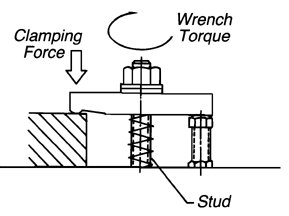Recent Posts
How do I determine the force needed to clamp my workpiece?
Posted by on
There are several factors that should be taken into account to determine the optimal clamping component to be used for your application. We would like to show you in this article a simple way of determining the minimum clamping force needed as a function of two variables: the power of your machine P (in HP) and the cutting speed V (in ft/min).

Let us assume that the work-piece will be clamped in a metal base or fixture and is on the same plane as the base. The force F (in Pound-force) will be enough to avoid any movement of the piece as the cutting tool moves. We are also assuming an n=75% efficiency of the power of your machine and a friction coefficient of M=0.2.
Machine power = 6 HP
Cutting speed = 100 ft/min
F= (P * n * 33,000)/ (M * V)
F= (6 * 0.75 x 33,000)/ (0.2 * 100)
F= 7,425 lbs-force
The coefficient of 0.2 works well for most applications although there are different coefficients depending on the material of the work-piece and clamp, and if they are dry or lubricated.
When it is cast iron over cast iron, the suggested coefficient in a dry operation is 0.30 if it is lubricated it is 0.19. For cast iron over steel in dry operation it is 0.19 an lubricated 0.10. For steel over steel dry 0.15 and lubricated 0.12.
These values are for reference only. There are other factors such as work-piece geometry, clamping area and forces from another axis that should be taken into account when selecting your clamping components.
 Loading... Please wait...
Loading... Please wait...
